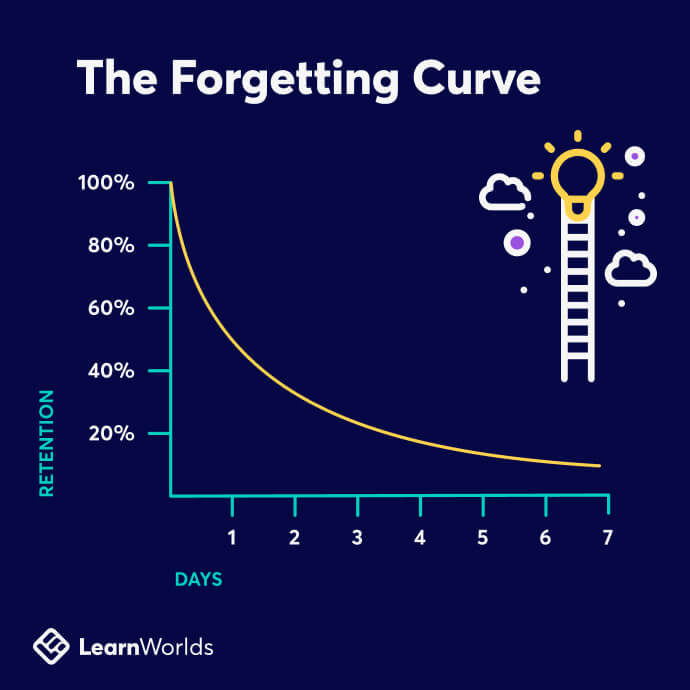Table of Contents
Welcome to the creator economy! Here, passions and skills turn into money for you and knowledge for your audience! Isn’t it gratifying to spread knowledge? It can be life-changing, whether it’s the type that enhances a resume, builds a new hobby, or kickstarts personal development.
However, have you ever wondered whether that critical knowledge sinks in and turns into real-life skills? You must understand that course effectiveness is not defined by completion rates only. A course is valuable only when it imparts knowledge that stays with the learner.
Even though some information is bound to fade with time, there are still strategies you can apply to help learners store information in their long-term memory and beat the forgetting curve.
The forgetting…what, now?
Ok, let’s take it from the beginning. We’ll explain what the forgetting curve is and how it jeopardizes knowledge retention in your courses, along with other factors. And, we’ll share knowledge retention strategies that work every time!
🤔 The Forgetting Curve
The (infamous) Forgetting Curve is a graph developed in 1885 by German psychologist Hermann Ebbinghaus. Ebbinghaus’s Forgetting Curve demonstrates how information is forgotten over time when we make no effort to retain it.

How did Ebbinghaus come up with the Forgetting Curve? Simply enough. He created nonsense syllables (consonant-vowel-consonant combinations with no meaning at all) and memorized them, testing his ability to recall them after different periods of time.
You might say that 1885 might be long ago, but the experiment’s validity still stands. A replication of the original experiment in 2015 brought similar results. And these results showed that up to 50% of knowledge is forgotten within the first day of being learned.
This might sound disheartening, but none of us is powerless against the forgetting curve – neither you, the course creator, nor your learners. You just need to know what works against and what is in favor of knowledge retention.
Read on because we’re declaring the enemies and allies of knowledge retention!
🦹 Enemies of Knowledge Retention
There are a few challenges that stand in the way of learning and safely storing information in our brains for the years to come. Here are 5 enemies to watch out for:
1Cognitive Overload
Cognitive overload happens when the brain has received too much information and can’t process it. So, if you try to feed your learners with tons of information at once, they won’t be able to take it in – and much less retain any. Not because they’re lazy but because the human brain is not cut out for that. It’s as simple as that.
2Choosing the Wrong Learning Material
Unfortunately, a lot can go wrong with the learning material and how information is presented – another factor that impacts retention. Training material that is too difficult, long, or boring, as well as content irrelevant to the course’s learning objectives, will fail to engage learners or facilitate their learning.
So make sure your content doesn’t resemble the KOJs and DAXs that Ebbinghaus tried to memorize. For example, if you’re teaching Sociology, don’t start talking about Statistics just because there’s some relationship between the two disciplines down the road– you’ll be off to a bad start.
3Stress and Sleep Deprivation
We don’t need to put forward some scientific study to demonstrate how lack of sleep compromises our ability to focus and receive information first, and consolidate and recall information, later. We have all experienced that.
Stress impacts learning and memory too. And although stress can enhance short-term memory, it impairs the brain’s ability to encode and recall memories, i.e., long-term memory. So bad news on that front as well.
4Time
Time is cruel in every sense and it makes no exceptions with our memory either. Knowledge loss is inevitable as time goes by, some of the knowledge stored in our brains is bound to leave us for good. And do you want to know what makes matters worse? 👇
5Lack of Repetition
People don’t learn one-off. (At least not the average Joe – we can’t really tell about those guys in NASA). We need some “follow-up” sessions and quick refreshers. If your learners don’t revisit what they’ve learned at frequent intervals – or if you don’t find a way to ensure they do while they’re still attending the course – the information won’t be stored in their long-term memory.
🦸 Allies of Knowledge Retention
The good news is that you can stand in the way of these enemies by integrating the following powerful knowledge retention strategies into your instructional design. Let’s see 10 trusted allies to help you beat the forgetting curve.
1Microlearning
Sleep-deprived learners? Overwhelmed students? Busy bees? Perfectly ready to learn but not really into two-hour lectures learners? We’ve got you covered.
Consider breaking down the content into bite-sized chunks. Microlearning is one of the most popular learning methods, and is effective for most learning needs. Here’s why:
2Spaced Repetition
Spaced repetition is a learning technique where the learner reviews and recalls information at spaced intervals. It can significantly enhance long-term memory and deep learning. There are no definite conclusions regarding the optimal space gap between the practices. However, the gap shouldn’t be too long, or the information will be forgotten and has to be learned from scratch. The gap can “widen” as time passes by.
Initiate course discussions about previously discussed topics, as well as current, to apply spaced repetition in your online course. You can also add ungraded eLearning assessments throughout the course to allow for simultaneous review and self-evaluation. Use a variety of assessments, from quizzes to open-ended questions and video submissions, to keep things interesting. Consider adding gamification elements, like badges, to encourage learners to keep coming back.
3Active Recall
Active recall of the information is an effective way to achieve higher learning retention. Active recall is actively retrieving information from your memory. It’s not the same as recognizing information (e.g., in multiple-choice quizzes when the learner identifies the correct answer among several options) or reviewing information (e.g., by studying).
An example of active recall is adding an open-ended question at the end of each module. And it doesn’t have to be about what you taught in that lesson. Any time you apply spaced repetition, choose questions and assignments that will encourage learners to “dig out” information they’ve stored.
4Building Upon Prior Knowledge
Prior knowledge should always be counted in as a factor when creating the learning material for the course. Each training session should introduce content with increased difficulty as the course progresses, following the principle that “knowledge is built upon knowledge.” You can also quickly recap what you discussed in the previous lesson at the beginning of each class before introducing new concepts and information.
5Social Learning
Course discussions are highly beneficial in online learning. They promote knowledge sharing and mentoring while learners “teach” and learn from one another. And they’re also an excellent opportunity to bridge knowledge gaps since learners will often stumble upon information they might have missed or misunderstood. And it all happens organically without the pressure of an exam or the strain of a long lecture.
And if your course is entirely self-paced? Then create a discussion forum where learners will interact and exchange knowledge, just like on social media. To promote social learning in your online course, you must choose an LMS with plenty of community features, like blogs, course discussions, and groups.
6Hands-On Projects and Collaborative Activities
Another way to help learners retain information is by encouraging practice. All the more so when teaching new skills that can be applied to manual, creative tasks. In that case, assign learners a creative project to work on together or in teams. Depending on what you’re teaching, this can be anything from writing a short story to creating a digital photo collage.
Another idea for collaborative and hands-on activities that require active participation is to do role-playing, where learners will have to handle real-world situtations. You can also hold webinars and workshops where learners will work together in real-time to solve problems.
7Taking Breaks
Frequent breaks help prevent cognitive overload and fight short attention spans. During a break, learners clear their brains and return more focused. In asynchronous eLearning courses, you can also “take a break” by introducing some modules here and there just to reiterate the information.
8Clean Learning Path and Clean Design
A cluttered user interface and content that is not presented following a logical sequence can fluster and frustrate learners, compromising the whole learning experience. To avoid this confusion in your online course, create a storyboard before building your course; it will help you create a clear learning path and strategically use the content throughout the course.
As for the course design, reduce visual noise with simple and easy-to-read fonts, a color palette of 2 or 3 colors, and familiar navigation buttons. It’s also pivotal to consider the needs of learners with disabilities and make your online course accessible to everyone.
9Visuals
Different studies have shown that visuals are more effective for long-term memory than auditory content, which works better for short-term retention. Visuals help learners link pieces of information and understand contrasting concepts or complex processes.
Design diagrams, graphs, and infographics to present information more attractively. Use vivid or contrasting colors. Add animations to your text and video. Interactive elements and visuals will improve learner attention and memory retention rates – talk about a sweet deal!
10Storytelling
People remember easier and longer things that impress them. Tell your learners a compelling story to evoke emotions during your live sessions or videos. Use real-life examples and case studies, or make up characters and stories. Trust us, no one cares if there’s no “Mark who accidentally handed over company records to cybercriminals” as long as Mark is memorable.
Remember What we Just Said?
Because we have a quiz coming up!
…Relax, it’s a joke!
If you want to try the knowledge retention strategies we discussed and create a hard-to-forget learning experience, LearnWorlds offers a 30-day free trial to create, share knowledge, inspire, and change people’s lives!
Further reading you might find interesting:

Androniki Koumadoraki
Androniki is a Content Writer at LearnWorlds sharing Instructional Design and marketing tips. With solid experience in B2B writing and technical translation, she is passionate about learning and spreading knowledge. She is also an aspiring yogi, a book nerd, and a talented transponster.

